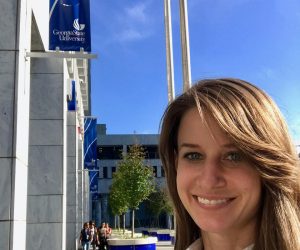The first-year MBA internship is arguably the second-most important milestone behind actually getting into business school. It is the moment where theory translates into praxis; when business school students have an opportunity to fully embody a year’s worth of knowledge and see how it applies to real-world situations.
Second-year MBA student Anna Collura ’20 took to the Yale SOM blog to explain how she applied lessons from her first year at Yale her internship at George State University this past summer.
Fridays from the Frontline: Yale SOM Internship Spotlight – Anna Collura ’20
by Anna Collura Yale MBA ’20
Internship: Georgia State University, Atlanta, Georgia
Hometown: Atlanta, Georgia
Favorite Professor: James Baron
Favorite New Haven eatery: Olmo
Clubs and affiliations: Forté Fellow, Consortium member, Education Leadership Conference co-chair, Yale Philanthropy Conference organizer, Nonprofit Board Fellow, and member of Women in Management, Design and Innovation, and Human Capital and Organizational Performance
Bonus facts: Past careers include teacher and professional dancer

Before coming to Yale, I spent nine years in K-12 education as a teacher, administrator, public policy fellow, and consultant ensuring students had access to an excellent education regardless of their race, family income, neighborhood, citizenship, or exceptionality. While I was proud of my work, the relationships I formed, the communities I served, and the incremental improvement in high school graduation rates, I was alarmed by what happened to students after graduation day.
While more low-income and minority students are pursuing post-secondary education than ever before, reporting by The Pell Institute shows that overall degree attainment for these populations remains stagnant. As a result, just as our economy demands more workers with post-secondary credentials, our universities are leaving more students behind—saddling them with debt instead of empowering them with a degree.
If I wanted students in the communities I served to live family-sustaining lives, I had to address this bottleneck. I decided to pursue my MBA to gain the organizational, financial, and managerial skills necessary to help public, private, and nonprofit institutions partner to improve graduation and workforce outcomes for traditionally underrepresented populations.
In pursuit of this goal, I’ve spent my summer interning with Georgia State University’s Student Success division. GSU is the largest public higher education institution in Georgia. By the numbers, GSU (not to be confused with the University of Georgia) serves more than 63,000 students in 250 degree programs at 7 regional and online campuses around Atlanta. As the school’s enrollment continues to grow, so does its share of minority and low-income students. Today, 71% of GSU students identify as minorities, 59% as low-income, and 25% as first-generation college students. In absolute terms, GSU enrolls more minority and first-generation students than any other Georgia higher education institution and more low-income students than all Ivy League institutions combined. GSU’s student population reflects America’s changing demographics, and in light of its size and diversity, one achievement stood out.
Georgia State University is the only national public higher education institution where Black, Latinx, first-generation, and low-income students match or surpass the institutional graduation rate. In the words of its 2018 Complete College Georgia Report, “Georgia State’s achievement gaps are gone.” This accomplishment has garnered praise from public figures including Bill Gates and Barack Obama and made it a beacon of inspiration for other institutions. After watching this success play out in recent years, my lingering question was, how? How does an institution that openly admitted to failing its students a decade ago achieve nation-leading gains in student outcomes without changing state appropriations or admissions selectivity?
As it turns out, more than 300 institutions that attended GSU’s regularly scheduled visit days over the past three years had the same question. During these events, GSU shares its turnaround story, but due to time constraints, the proceedings are limited to a discussion of GSU’s philosophy, programs, and results. While GSU’s administrators generously offer their time to answer follow-up questions, it is extremely time consuming and the support they can realistically provide is limited.
See the rest of Anna’s account here.









